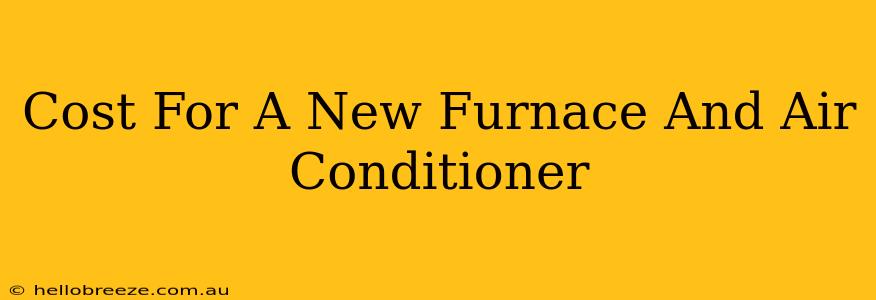Planning to replace your old, inefficient furnace and air conditioner? Understanding the cost is crucial for budgeting and making informed decisions. This guide breaks down the factors influencing the price of a new HVAC system, helping you navigate the process with confidence.
Factors Affecting the Cost of a New Furnace and Air Conditioner
Several key factors significantly impact the total cost of installing a new furnace and air conditioner. These include:
1. System Size and Type:
- Heating System: Furnaces range from basic gas furnaces to high-efficiency models with features like variable-speed blowers and modulating burners. The larger the home and the colder the climate, the larger and more powerful (and expensive) the furnace needs to be. Consider heat pump systems as a potentially more cost-effective and energy-efficient alternative, especially in milder climates.
- Cooling System: Air conditioners, similarly, vary in size (measured in tons), efficiency (SEER rating), and features (like two-stage cooling or variable-speed compressors). Higher SEER ratings indicate greater energy efficiency and, typically, higher upfront costs. Think about ductless mini-splits if you're looking for zoned cooling or a more efficient solution for additions or smaller spaces.
2. Brand and Model:
Different manufacturers offer varying levels of quality, features, and warranties. Recognized brands often come with a higher price tag, but may also offer superior reliability and longer lifespans. Researching different brands and models helps find the best balance between cost and performance. Consider the warranty period offered by different manufacturers; longer warranties often denote greater confidence in the product's durability.
3. Installation Costs:
Installation costs vary depending on several factors:
- Labor Costs: Labor rates differ by region and installer. Get multiple quotes to compare pricing. The complexity of the installation—factors such as ductwork modifications, new electrical wiring, or refrigerant line installation—can significantly affect the cost.
- Permitting and Inspections: Local building codes might require permits and inspections, adding to the overall expense.
- Ductwork Upgrades: If your existing ductwork is inadequate, repair or replacement will increase the total cost. Proper ductwork is essential for efficient heating and cooling, so don't overlook this aspect.
4. Additional Features and Upgrades:
Numerous optional upgrades can enhance comfort and efficiency but also increase the initial cost. These include:
- Smart Thermostats: Smart thermostats offer programmable scheduling, remote control, and energy-saving features.
- Air Purifiers: Improve indoor air quality with advanced filtration systems.
- Zoned Heating and Cooling: Allows for customized temperature control in different areas of the home.
Estimating the Cost:
Expect a wide range in costs. A basic system might cost between $5,000 and $10,000, while high-end systems with many features can easily exceed $15,000. Get at least three quotes from reputable HVAC contractors to compare prices and offerings. Be sure the quotes clearly outline all included components, labor, and any additional fees. Don't hesitate to ask questions and clarify any uncertainties.
Saving Money on Your New System:
- Rebates and Incentives: Many utility companies and government programs offer rebates or tax credits for installing energy-efficient HVAC systems. Explore available incentives in your area.
- Financing Options: Consider financing options to spread the cost over time.
- Shop Around: Compare prices from multiple contractors and look for sales or special offers.
Replacing your furnace and air conditioner is a significant investment. By carefully considering the factors outlined above and obtaining multiple quotes, you can make an informed decision that balances cost, efficiency, and long-term value. Remember, a higher upfront cost for a more energy-efficient system can often translate to significant savings on energy bills over the system's lifespan.

